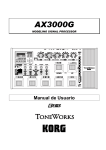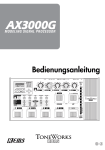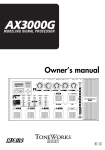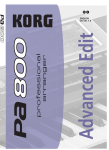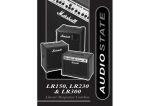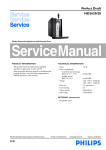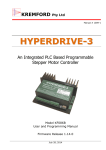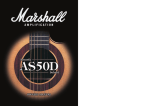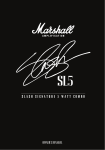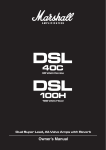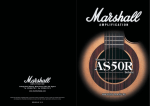Download Korg AX3000G Stereo System User Manual
Transcript
EasyStart Main Features Korg’s REMS modeling technology delivers 72 realistic classic and modern amp, cabinet and effects models 16 types of drive & amp models cover everything from vintage overdrive to high-gain metal 11 types of pre-effect, cabinet, modulation, delay and reverb modeled effects deliver a broad sound palette Transform your guitar with pickup, acoustic body and top, plus synth modeling effects 32 preset programs are provided, and the internal memory can hold 96 of your own original programs Up to seven effects can be used simultaneously Knob-based interface for quick, intuitive editing Assignable control switch and expression pedal with 8 point LED pedal indicator for real-time parameter control New ESS (Expression Step Sequencer) automatically controls most effect parameters in a fixed or random step function that can create radical sound changes! Insert send/return jacks let you connect your favorite external effect units MIDI IN/OUT allows you to edit and store original sounds on your computer using the dedicated editor/librarian software (Windows and Macintosh are supported) Amp/line selector is included for maximum output versatility. Choose from 3 different amp types! Heavy-duty metal chassis stands up to the rigors of travel and stage performance Auto Chromatic tuner with highly visible 8 point LED allows bypassed or muted (silent) tuning Backlit LCD ensures easy visibility EasyStart CONTENTS Connections; Tuning; Selecting Programs 2 Saving Programs; Individual Mode; Expression Quick Assign; 3 ESS (Expression Step Sequencer) 4 The Control Switch; Restoring the Factory Programs 5 AX3000G EasyStart Cable and Guitar Connections 1. Use audio cables to connect the L/MONO and R OUTPUT jacks to a mixer/recorder. For headphones, plug into the 2. After making audio output and AC connections, connect your guitar to the INPUT jack on the rear panel. 3. Raise the MASTER level to adjust the volume as you play. PHONES jack. When connecting to a mono device i.e. guitar amp, use the L/MONO output only. Output Connection settings The AX3000G offers a variety of different output connection settings. To ensure that you take full advantage of the AX3000G’s amazing tone, make the proper AMP/LINE setting. Note: The AMP/LINE settings include three different amp settings and one line setting. 1. For connection to headphones or powered monitors, press the AMP/LINE button, then use the ▲/▼ buttons 2. For connection to a guitar amplifier, press the AMP/LINE button, then use the ▲/▼ buttons or rotate VALUE or rotate VALUE KNOB 1 to select LINE. KNOB 1 to choose from three different types of guitar amps selections: AP1: Choose this setting if you’re connected to a clean-sounding amp such as an open-backed US-manufactured combo amp. AP2: Choose this setting if you’re connected to an amp with a distinctive sounding Mid-range such as a UKmanufactured open-back combo Amp. AP3: Choose this setting if you’re connected to a stack with a closed-back 4 x12 cabinet(s). Tuning When you power-on the AX3000G and make the connection settings above, you’ll be in “Program Select” mode. You can then choose to tune your guitar in one of two ways: To tune audibly: 1. Press and hold down the currently selected PROGRAM SELECT switch (1, 2, 3, or 4) for about half a second - all effects will be bypassed, and the PROGRAM LED will blink. The name display will indicate “BYPASS” for one second, and the Auto Chromatic Tuner will now be activated. Use either the LCD display or expression pedal led’s to tune your guitar. 2. When you’ve finished tuning, press the flashing PROGRAM SELECT switch to return to Program mode. (Note; pressing another PROGRAM SELECT switch will select a different program and return you to Program Mode.) To activate Mute and tune silently: 1. 2. Press and hold down the currently selected PROGRAM SELECT switch (1, 2, 3, or 4) for about 1.5 seconds; the output will be muted. The program LED will blink rapidly and the name display will show “MUTE” for one second. The Auto Chromatic Tuner will now be activated; use either the LCD display or expression pedal led’s to tune your guitar. When you’ve finished tuning, press the flashing PROGRAM SELECT switch to return to Program mode. (Note; pressing another PROGRAM SELECT switch will select a different program and return you to Program Mode.) Selecting and listening to the AX3000G’s Preset Programs The AX3000G has 96 program locations in 24 banks, with 4 programs in each bank. The BANK UP/DOWN switches allow you to select a bank, the PROGRAM SELECT switches allow you choose one of four programs within a given bank. Once you find a sound that you like, you can use the knobs and selectors in the amp/effects section to tweak your tone easily. Note: All of the AX3000G programs are rewritable. To select a Program: 1. Make sure that the AX3000G is in PROGRAM SELECT mode (automatically selected on power-up). 2 AX3000G EasyStart 2. Press either the BANK UP or BANK DOWN switch to select “BANK 2”. (When you’re selecting a bank, the bank number will flash in the BANK display). 3. Press the PROGRAM SELECT 3 switch. Program “2-3” will be displayed in the LCD instantly. The PROGRAM SELECT 3 switch LED will light and the Bank Display will indicate 2, and stay lit. ! If the LED in the upper left of the Bank Up switch is lit green, Individual Mode is selected. Press the BANK UP switch to choose Program Select mode. Saving a Program You’ve tweaked and turned some knobs, and you like the changes that you’ve made – now to save your program: 1. Press the WRITE button. The name display indicates “*WRITE*”, and the BANK display and PROGRAM LED’s 1–4 will flash. 2. Use VALUE KNOB 1, the ▲/▼ buttons, or the BANK UP/DOWN switches to select the bank you want to use; then use the </> buttons, or PROGRAM SELECT switches to select the destination program 1–4. 3. Press the WRITE button once again. The program will be saved, the name display will indicate “COMPLETE,” and you’ll return to Program Select mode. ! The newly-saved program writes over the previous contents of that bank/program. If you decide not to store your new program, press the EXIT button to cancel the procedure. Note that if you switch to a different program or turn off the power without storing the Program you edited, your changes will be lost. Individual Mode In this mode, you can individually turn each effect type on or off just as if you were using a collection of stomp boxes. You can select INDIVIDUAL mode from any program. 1. To enter INDIVIDUAL mode from PROGRAM SELECT mode, press and hold the BANK UP switch for about one second; the LED above the BANK UP switch will light green. Here’s how to switch the pre-effect and reverb on or off while you’re playing: 2. Press the “program select” switch 1 to turn the pre-effect on/off. The LED 1 lit/ dark state indicates the on/off status of the pre-effect. 3. Press the BANK DOWN switch to turn the reverb on/off. The LED at the upper left of the BANK DOWN switch will be lit or dark to indicate the reverb’s on/off state. 4. To exit INDIVIDUAL mode, press the BANK UP switch, and the green LED will go dark (not lit). Expression Target Quick Assign Here you can easily assign many effect parameters of the AX3000G to its expression pedal for real time live control! For example, you can assign the speed of a modulation effect, time of a delay, or mix of the reverb to the expression pedal. And of course, the expression pedal can also act as a volume pedal or wah pedal effect. As an example, let’s assign the Pitch parameter of the PITCH SHIFTER to the expression pedal: 1. Use the Modulation MODEL SELECTOR to choose the PITCH SHIFTER. 2. Rotate VALUE KNOB 1 or use the </> buttons to select the “PITCH” parameter. (PITCH” will be indicated in the LCD) 3. In this state, press and hold the EXP/CTL button for one second, the name display will indicate “COMPLETE”. That’s it! The PITCH parameter has now been assigned to the expression pedal, letting you control the amount of PITCH SHIFT. 3 AX3000G EasyStart ESS (Expression Step Sequencer) The AX3000G features an Expression Step Sequencer (ESS), which automatically controls most effect parameters in a fixed or random step function. You can assign up to eight steps of effect parameter values in the step sequencer, and specify one of seven ways in which the sequencer will play back these steps: Forward, Backward, Alternate 1/2, Random, Forward (oneshot), and Alternate 1/2 (one-shot). This lets you create sounds with complex movement that were unachievable until now. The AX3000G’s ESS function operates between the expression pedal and the target parameter you specify. When you activate ESS, the sequencer will control the target parameter that you specified for the expression pedal, and the expression pedal will control the ESS. Using ESS First, specify the target parameter that is to be controlled by ESS by assigning it to the expression pedal (see Expression Target Quick Assign section) Assign the PITCH parameter of the PITCH SHIFTER as the target parameter for the expression pedal, and then… 1. Press the EXP STEP SEQ button to activate ESS. 2. Use VALUE KNOB 3 to specify how the sequencer will operate. For this example, choose “8-A”, so that the sequencer will cycle through steps 1–8 and then 8–1. 3. Specify the value for each step. First use VALUE KNOB 4 to set “STEP” to “1”, and then use VALUE KNOB 5 to specify a value of “0”. 4. Repeat the above action for steps 2 through 8, and set these steps to values of 2, 4, 5, 7, 9, 11, and 12 respectively. 5. Use VALUE KNOB 1 to determine the Speed of the Step Sequence. 6. Use VALUE KNOB 2 to adjust to the Smooth parameter. This determines how dramatic of a change there is between each sequence step. ! If VALUE KNOB 1 is set to PEDL, the expression pedal will control the pitch changes. Otherwise it will control the speed of the ESS. Here are a few more examples of some amazing new sounds you can create using the ESS function: EX1: Pentatonic ESS This is based off of a “6A pattern” using the ESS combined with the pitch shifter’s pitch parameter as described above. The ESS settings are as follows: SMOOTH STEPMODE 0 ! 6-A STEP1 STEP 2 0 7 STEP 3 10 Pitch shifter: Pitch=0, Fine=0, tracking=80, direct=0.0, effect=7.0 Amp: US Modern (Gain=9.4, Treble=7.0, Middle=0.0, Bass=6.2,) Cab: UK T75 Cross delay: (Time=638, Feedback=4.0, Mix=6.8) STEP 4 12 STEP 5 15 STEP 6 12 Make sure that the EXP/CTL Button is set to M/Pitch. Control the speed of the ESS with the expression pedal EX2: Major Arpeggio ESS Based off of the preset program 6-4 which was originally a minor arpeggio using a 7A Pattern. 4 AX3000G EasyStart Step 2 has been changed from -9 to -8, and step 5 from 3 to 4 (this changes it to a major arpeggio) The ESS settings are as follows: SMOOTH STEPMODE 0 7-A STEP1 -12 STEP 2 STEP 3 -8 -5 Pitch shifter: Pitch=0, Fine=0, tracking=80, direct=0.0, effect=7.0 Delay: 2 Tap Delay Time: 756, Feedback 4.4, Reverb: Tone 7.9, STEP 4 0 STEP 5 STEP 6 4 STEP 7 7 12 Tap Time 5.0, Mix 4.4 Slap… Time=7.7, Lo Damp 3.7, High Damp 5.4, Pre Delay 0, Mix 4.5 The Control Switch You can assign the control switch to function in a variety of ways. It can act as an on/off for your effects/amp/cab models; a tap tempo for modulation or delay, or even as a trigger for the ESS. Below is a list of the Control Switch functions. You can make the following settings independently for each program for extra flexibility! Press the EXP/CTL button and use VALUE KNOB 5 to select the effect you want to control, and then press EXIT to return to Program mode… Control Switch Effect On/Off: Control Switch Effect Control: • “I/ON OFF” External Insert effect on/off • “FLN TRIG” Activates Classic Flanger LFO • “P/ON OFF” Pre-effect on/off • “HOLD DLY” Activates HOLD of Hold Delay • “A/ON OFF” Drive/Amp model on/off • “FREEZ” Activates Freez of Freez effect • “M/ON OFF” Modulation effect on/off • “ESS CTL1” Turn ESS on/off • “D/ON OFF” Delay effect on/off • “ESS CTL2” Turn the effect being controlled by ESS on/off • “R/ON OFF” Reverb effect on/off • “ESS TAP1” Tap tempo to specify the time between each Control Switch Tap tempo: • ESS TAP2” Tap tempo to specify the time between step 1 and the sequence step • MOD TAP” Modulation TAP TEMPO last step of the sequence. • DLY TAP” Delay TAP TEMPO ! • “ESS TRIG” Restart step sequence from step 1 ESS TAP1, ESS TAP2, and ESS TRIG will do nothing if the SPEED of the step effect is set to PEdL. Restoring the Factory Preset Programs Here’s how you can restore the AX3000G’s programs and settings to the state in which it was shipped from the factory: 1. ! While simultaneously holding down the ▲/▼ buttons and the EXIT switch, power-up the AX300G. The Bank Display will read “P”, the LED 1–4 buttons will flash, and the name display will ask “RELOAD?” Release the ▲/▼ buttons and the EXIT switch. If at this point, you decide that you really don’t want to execute this operation, press the EXIT switch. 2. Press the WRITE button. The name display will show “LOADING,” and the factory data will begin reloading. When completed, the name display will indicate “COMPLETE,” and the AX3000G will automatically switch to Program Select Mode. ! If there are any settings you want to keep, you should first use the Backup Program Data function (programs can also be saved via our free AX3000G Editor/Librarian software; available at www.korg.com/AX3000G), or write down your settings using the Original Value icon. See the AX3000G Owner’s Manual for additional information on using the Backup Program Data function/ Original Value icon. For more information, see your AX3000G Owner’s Manual, and be sure to visit www.korg.com/AX3000G for more tips and tricks!! 5





